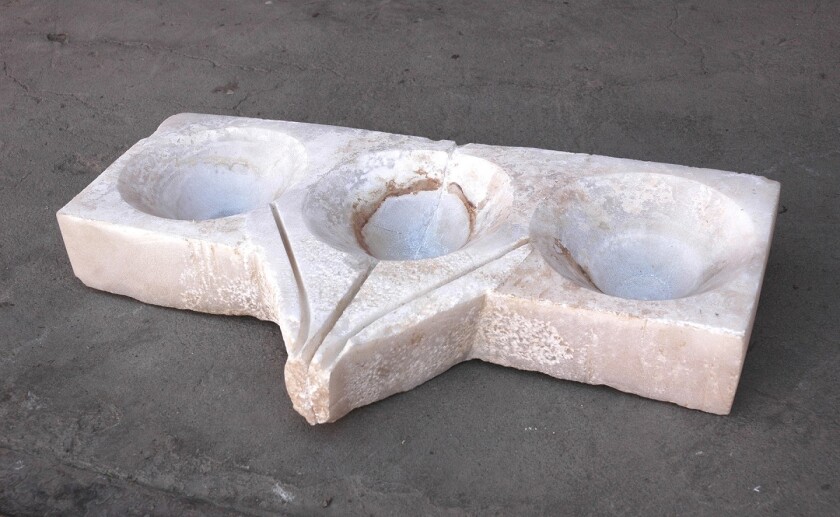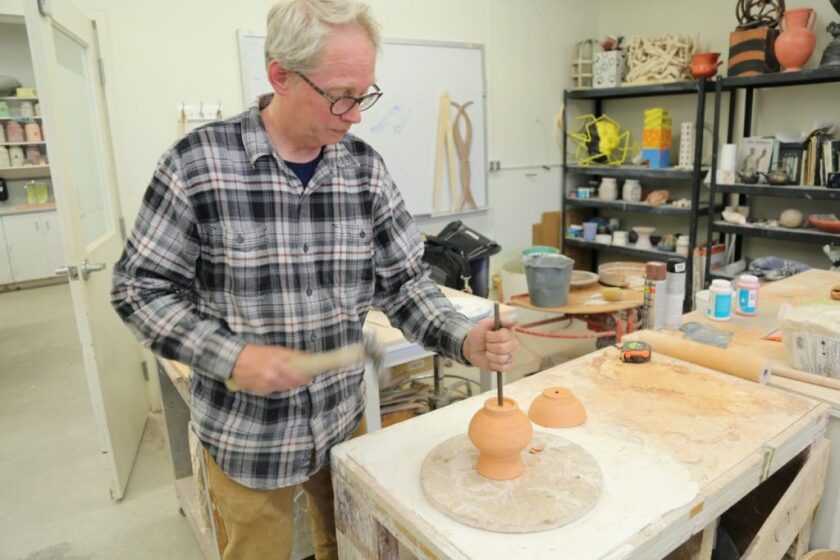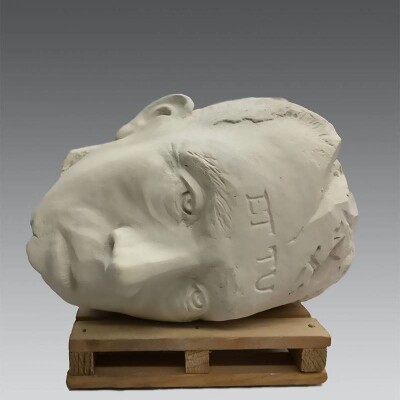Rooted in materials, history and conceptualism, Christensen’s artwork explores the human connection to the earth and to each other.
To view more of Christensen’s artwork, visit brian-christensen.com, or follow him on Instagram @briandeanchristensen.
Artist and BYU art faculty member Brian Christensen has a longstanding interest in archeology. At the age of 12, he volunteered on the archeological site at the Bancroft Ranch House, a San Diego State University project, where he screened dirt and examined grave goods of the Kumeyaay peoples indigenous to the area.
As a teenager, Christensen explored the Shoshone trail that crossed a hilltop near his family’s ranch in Manilla, Utah—a route that, in retrospect, Christensen said was probably used for thousands of years. Littered with buffalo points, arrowheads and stone flakes, this particular section of the trail seemed to have been a quarry site.
“Because of the experience I had as a kid in San Diego,” Christensen said, “I was able to recognize the worked stones that were not so recognizable as arrowheads, but as cores that were flaked off, and the flakes themselves. All those kinds of things. I don't collect artifacts, but I try to preserve their context by leaving them undisturbed.”
Since then, Christensen has continued to find remnants of former peoples throughout Utah, and some of what he finds influences his art.

Craft Consultant in Egypt
In the spring of 2014, Christensen had the opportunity to travel to Egypt as part of an excavation team comprised of experts in fields related to archeology. He was recruited for his expertise in ceramics and served in a craft consultant capacity, analyzing ancient artifacts and developing hypotheses about their purpose and methods of construction.
At the request of the Ministry of Antiquities in Egypt, Christensen restored a libation altar found at the 4,600-year-old Seila Pyramid of Snefaru using a glue made from epoxy resin and ground travertine. He also made a digital rendering of the altar and a limestone model for display in the Joseph Smith Building on campus.

In addition to restoring the altar, Christensen formulated a theory for holes he observed in the bottom of Coptic Roman pots that had been excavated from a nearby cemetery. From his experience with pottery, he didn’t think these holes could have had a functional purpose. “If you needed a funnel, the potter would never break the hole after it was made,” Christensen said. “They would throw something that looked like a funnel.” Christensen began to wonder if the holes were part of a ceremonial practice for decommissioning pots. It reminded him of a practice among the Pueblo tribes of the American Southwest, who punched holes in pots to let the spirit out when the owner died.
“Of course there is no connection,” Christensen said, given the physical distance between the populations. “Except that in grave processes, people often come to the same ceremonial conclusions.” Christensen tested his theory back at BYU by making two replicas of each pot and punching two holes in each one—once from the bottom and once from the top.
“What I found is that if you were to try to push slowly on the pot with pressure, you would break the pot to pieces,” Christensen said. “If you were to strike with something soft, like wood, it would also break to pieces. It takes a metal punch and a hammer to make a clean hole through the pot, which shows it had to be very intentional.”
In a chapter Christensen helped write for the book, “Excavations at the Seila Pyramid and Fag el-Gamous Cemetery,” he explains that while it is unclear why holes were punched in the pots, it is clear it was done to prevent their further use. It is also understood that pots were “killed” in various ways over a long period of time in Egypt, but for seemingly different reasons. Christensen and his fellow researchers hope that by adding to the pool of collective knowledge about ancient Egypt, they will aid future scholars in finding meaningful answers about the past.

Uniting the Past and Present
“We’re always making new discoveries and new contextualization for what people in the past were thinking about,” Christensen said.
Regarding his personal interest in archeology and how it influences his artwork, Christensen said he is “always thinking in terms of precedents. What did people think about in the past, and how can I learn from that? How can I avoid making the same mistakes? How do I add to their contributions?”
We’re now in the era of the Anthroprocene, Christensen said, referring to the unofficial unit of geologic time used to describe the current period in which human activity has significantly altered the planet’s climate and ecosystems—and humans have existed long enough to become fossilized.
“I like exploring the idea that we are in this ongoing record and are part of the earth, not separate from it,” Christensen said. “That we, ourselves, are part of a fossil record.” As an artist, Christensen makes a lot of portraits, including head and body studies, that weave together personal and cultural history through references to literature, artifacts and symbols. Sculpting the human face becomes a powerful way for him to unite the past and the present.
“Many aspects of the past are incomprehensible because of a lack of contemporary context,” Christensen said, “but a face, the written or remembered word, the figure, cuts through all of that. There is art evidence that even the earliest humans created, that shows us that we are and always have been connected in mind and body.”
Artifacts themselves, or at least their likeness, also appear occasionally in Christensen’s work. The thing about clay, Christensen explained, is that it can be manipulated to imitate virtually any material, including sandstone, marble or wood. Christensen’s ceramic works often incorporate hyper-realistically detailed textures of rocks, trees and other aspects of nature. Some of his large-scale heads—usually about two feet tall and one foot wide—appear to be made of stone and fossils.

Pam Bowman, a former student of Christensen’s who has maintained a friendship with him for 20 years, noted his remarkable ability to work with a wide variety of techniques and materials.
“He seems to know how to do anything and do it well,” she said. “Because of his technical skill, he can choose the methods and materials that will best put across the concepts he wishes to portray.” Those concepts, she added, are his other strength. Besides being visually interesting, Christensen’s artwork is thoughtful, intelligent, and grounded in art history and other intellectual disciplines, as well as personal experience.
While looking toward the past, Christensen also frequently experiments with new sculptural and digital processes. He serves as the area coordinator for ceramics, but works across many sculptural mediums and is known throughout the department for being knowledgeable and generous. Students value his patience, support and encouragement as they pursue personally meaningful ideas.
To view more of Christensen’s artwork, visit brian-christensen.com, or follow him on Instagram @briandeanchristensen.
